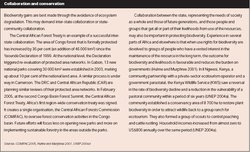Biodiversity and development challenges in Africa
Contents
- 1 Introduction: development challenges Expanding agriculture is an important cause of habitat loss. Newly planted fields, Morocco. (Source: J. C. Mohamed-Katerere) The imperative to improve human well-being can place multiple and often competing demands on ecosystems. Difficult trade-offs may have to be made, for instance between the protection of habitat for biodiversity (Biodiversity and development challenges in Africa) , and the transformation of ecosystems for human needs. Some ecosystem transformation is inevitable if the Millennium Development Goals (MDGs) are to be met, but the impact on biodiversity will depend on how development activities are carried out. Significant opportunities exist to generate wealth through activities that draw on environmental goods-and-services, and at the same time promote the conservation of these resources. These activities include a range of moderate intensity extractive uses, such as livestock or wildlife ranching, wild plant harvesting, lowimpact logging, and sustainable fisheries, as well as nonextractive uses, such as nature-based tourism and the exploitation of genetic resources.
- 2 Strategies for enhancing opportunities from biodiversity
- 3 Conclusion
- 4 Further reading
Introduction: development challenges Expanding agriculture is an important cause of habitat loss. Newly planted fields, Morocco. (Source: J. C. Mohamed-Katerere) The imperative to improve human well-being can place multiple and often competing demands on ecosystems. Difficult trade-offs may have to be made, for instance between the protection of habitat for biodiversity (Biodiversity and development challenges in Africa) , and the transformation of ecosystems for human needs. Some ecosystem transformation is inevitable if the Millennium Development Goals (MDGs) are to be met, but the impact on biodiversity will depend on how development activities are carried out. Significant opportunities exist to generate wealth through activities that draw on environmental goods-and-services, and at the same time promote the conservation of these resources. These activities include a range of moderate intensity extractive uses, such as livestock or wildlife ranching, wild plant harvesting, lowimpact logging, and sustainable fisheries, as well as nonextractive uses, such as nature-based tourism and the exploitation of genetic resources.
As already discussed, despite significant environmental change, Africa still has a significant store of biodiversity. The key challenge in promoting sustainable natural resource use is to ensure that the rate of extraction (including the incidental damage caused during the harvest process) remains within the limits of sustainability. Strategies to ensure sustainability may rely on a combination of protection strategies including protected areas and conservation measures within “used-and-lived-in” spaces. Important challenges are how to:
- Determine the sustainable extraction rate and practices; and
- Establish and maintain institutions that are able to regulate natural resource use within the limits without placing undue constraints on their legitimate use.
Habitat degradation and loss
Habitat refers to the range of resources that a species needs to maintain a viable population including sufficient territory, necessary food and water, and required physical features such as tree cover, rocky hills or deep pools, as well as the organisms and ecosystem disturbances that must be present for it to complete its life cycle. The major current cause of biodiversity loss in Africa is habitat loss and that is likely to remain true for the first third of the 21st century.
Habitat is lost when land cover (or its aquatic equivalent) is changed, usually as a result of changing use by humans. Common examples are the conversion of near-natural vegetation to temporary or permanent croplands; the replacement of forest by pastures; the expansion of human settlements; and the alteration of river habitats by dams, pollution and removal of water for human use. Forests and woodland cover is declining at a rate more or less equivalent to the increase in cropland. The terrestrial ecosystem type where the greatest degree of habitat loss has occurred is grasslands, which have been converted to cereal agriculture.
Habitat fragmentation – the division of continuous patches into smaller pieces which are partly or fully disconnected from one another by infrastructure, agricultural fields or human settlements – can have similar outcomes for biodiversity as outright habitat losses. First, the “edge effect” disrupts biodiversity for a considerable distance into the remnant patches. Second, the number of species that can be supported in the long term depends on habitat size.
Overexploitation of resources
If renewable resources are harvested at a rate greater than their regeneration rate, the long-term flow of benefits is reduced, and they are said to be overharvested. When natural capital is drawn down too far, fundamental ecosystem changes can occur which make ecosystem recovery to full service delivery potential very slow or impossible, and degradation is said to have occurred. Degraded ecosystems support half or less of the biodiversity of non-degraded used ecosystems.
Much overharvesting is the unintended side effect of activities aimed at harvesting just one or a few components of the ecosystem. The discarded “bycatch” in fisheries and the habitat destruction caused by logging are examples of this. Regulatory policies that pay no heed to anything other than the target species encourage this kind of damage.
Overharvesting is a problem in many localities. For example, about 9 percent of rangelands south of the equator are grazed by domestic livestock at unsustainable rates. The fish stocks in the Great Lakes (Lake Victoria in particular) show classic symptoms of overfishing, and marine fish stocks in Western and Eastern Africa are at risk of overfishing.
Strategies for enhancing opportunities from biodiversity
While significant challenges for researching and managing biodiversity in Africa remain, there is enough information available to give broad but concrete direction to the development of national, sub-regional and regional biodiversity policy.
Multilateral agreements
Many multilateral environmental agreements (MEAs) exist to promote biodiversity protection. Most African countries have ratified the Ramsar Convention (protecting wetlands of international importance), the Convention on International Trade in Endangered Species of Wild Fauna and Flora (CITES), the Convention on the Conservation of Migratory Species of Wild Animals (CMS), the Convention Concerning the Protection of the World Cultural and Natural Heritage (the World Heritage Convention), the United Nations Convention to Combat Desertification (UNCCD), the United Nations Framework Convention on Climate Change (UNFCCC), and the Convention of Biological Diversity (CBD). These global MEAs are complemented by sub-regional and regional agreements, such as the African Convention on the Conservation of Nature and Natural Resources (ACCNNR) and the New Partnership for Africa’s Development (NEPAD) Environmental Initiative. The 2002 World Summit on Sustainable Development (WSSD) saw convergence on a shared vision of sustainable development as a way of alleviating poverty, raising human well-being, and simultaneously meeting biodiversity protection objectives. Recognition of the administrative burden that the multiplicity of environmental agreements places on resourceconstrained governments has prompted a desire to rationalize their implementation. Among the conclusions of the WSSD was that the link between the conservation of natural resources and economic development in Africa is particularly close.
The CBD is particularly focussed on biodiversity. It has three objectives:
- The conservation of biodiversity;
- The sustainable use of its components; and
- The equitable sharing of benefits arising from the use of biodiversity.
Realizing any one of these objectives is dependent upon the other. This requires adequate political and legal instruments to appropriately allocate access, benefits and costs and to make linkages between different environmental sectors as well as with development sectors. Such an approach is discussed in Interlinkages: The Environment and Policy Web in Africa. Partnerships with non-governmental organizations (NGOs), community-based organizations, and the technical and scientific community play an important role in conservation planning and policy. Such partnerships are also critical to the success of implementation efforts.
Biodiversity policy
A cost-efficient and robust strategy for biodiversity conservation may have two pillars. The first pillar is the classical approach of identifying those parts of the land, waters and sea where the conservation value exceeds any other use value, and requires strict protection. The second pillar recognizes that, even with such a safety net in place, most wild organisms live in places that are used primarily for purposes other than biodiversity conservation. Adjustments to the way in which these ecosystems are used can lead to a high degree of biodiversity preservation, without unacceptable decreases in the output of other services.
The key issues for establishing an effective protected area network are prioritization of levels of protection and use. Identifying protected areas should not be arbitrary. Sufficient knowledge exists to apply more refined techniques to identify locations that are critical for many species, robust to climate change, and have a good chance of being economically viable. In general, consolidated reserves are more viable than the equivalent area of isolated patches. In some instances transboundary parks are important for habitat protection.
There are known priority areas for conservation in every country, but overall, the greatest current urgency relates to multitaxon centres of endemism, such as the Eastern Arc mountains and Mt Cameroon. As shown in Box 1, adopting collaborative approaches at multiple levels can be important for achieving biodiversity conservation objectives.
Improving science
About US$245 million is currently spent annually by the international community for protected area management in Sub-Saraha Africa (SSA). The efficacy of these investments depends partly on the availability and reliability of information on the spatial distribution and condition of biodiversity. The currently available information on biodiversity is inadequate in several respects:
- It is biased towards terrestrial biodiversity, and towards large mammals and birds. The greatest proportion of Africa’s biodiversity, invertebrates, is not well known to science.
- For most species, only parts of their distribution ranges are documented. In many areas there is inadequate documentation, including in Ethiopia, the Congo basin, Angola and Mozambique.
- Information on the biodiversity actually conserved in protected areas (eg in the form of species inventory lists) is widely lacking but is essential to document the success of conservation measures currently undertaken and to guide further conservation activities.
- A vast amount of locally and regionally available biodiversity information is not connected and standardized, which is a significant impediment to making priorities comparable at regional to global scales.
- Data on biodiversity condition (ie population size and trend, rather than simple presence or absence) is virtually absent. This information is essential for effective conservation of viable populations and for giving warning of impending problems well before they are irremediable.
- Biodiversity measures are still commonly restricted to how many species there are, while there is very little information on qualitative aspects of biodiversity such as phylogenetic or functional diversity.
Other important areas of research that would support effective biodiversity policy include: quantification of the current and potential economic benefits provided by ecosystem services, and the consequences and costs of ecosystem destruction; understanding the link between ecosystem diversity and ecosystem integrity; methodologies for the integration of climate change adaptation strategies into conservation planning; and the development of a conceptual basis and methodology to incorporate biodiversity sustaining and generating processes and functional biodiversity into conservation strategies.
Conclusion
Biodiversity is in need of wise management, not simply to satisfy international pressures and obligations, but because it is the basis of most rural livelihoods and is the foundation of major new economic sectors that offer the prospect of better, more sustainable lives.
As New Partnership for Africa's Development (NEPAD) has recognized, development cannot be achieved through dependence on outside resources, but must rely on the best use of local resources. Biodiversity is one of these, and represents a formidable natural asset. For example, the international trade in flowers bred from a large number of plant species originating in Africa is worth billions of dollars annually, almost all of which accrues outside Africa. For the opportunities offered by biodiversity to be realized, new strategies, which go beyond a focus on a few species and parks, will need to be adopted. New links need to be made between protecting biodiversity and human needs. There is a need for more function-oriented conservation of ecosystem services essential for human livelihood, including the peopledominated landscapes outside parks.
The coincidence of centres of biodiversity, human cultural heritage and intensive land use partly defines the necessary strategy for conservation and sustainable use policy. If viable populations are to be preserved, particularly in the light of an uncertain future climate, biodiversity conservation cannot be restricted to protected areas, but has to be incorporated as part of sustainable land use even in densely settled areas. Likewise, conservation of human culture within centres of biodiversity requires approaches different from the concept of protected areas exclusively dedicated to species conservation. Except under special circumstances, for example, where nature tourism is the best economic land use, species and park-centred strategies of biodiversity conservation are unlikely to achieve poverty reduction goals. Although biodiversity conservation objectives often overlap with other priorities for sustainable use (for example, the conservation of water catchment areas), the overall outcome of such integrated strategies will need to go beyond solely biodiversity-centred conservation targets. This principle is reflected in the “ecosystem approach” adopted by the CBD in 2000 and underlies the interlinkages approach discussed in Interlinkages: The environment and policy web in Africa. Clear and convergent objectives, verifiable targets, collaboration and coordination between conventions and between countries, focused and sustained capacity-building, and harmonized reporting requirements are needed to advance the regional development objectives.
Further reading
- Adams, W.M., 2001. Green Development: Environment and Sustainability in the Third World (2nd Edition). Routledge, London
- Adams,W.M. and Hulme, D., 2001. If community conservation is the answer in Africa, what is the question? Oryx. 35(3), 193-200
- Balmford,A. and Gaston, K.J., 1999. Why biodiversity surveys are good value. Nature. 398, 204-5.
- Carret, J.C. and Loyer, D., 2003. Comment financer durablement le réseau d’aires protégées terrestres à Madagascar? Proceedings of the Vth World Parks Congress. Durban, South Africa, 8-17 September.
- COMIFAC, 2005. Le Plan de Convergence,Tradition et Modernité: Une plate-forme commune d’actions pour le Bassin du Congo. Central African Forests Commission.
- Gaston, K.J., and Rodrigues, A.S.L., 2003. Reserve selection in regions with poor biological data. Conservation Biology. 17, 188-95.
- Hulme, D. and Murphree, M. (eds. 2001). African Wildlife and Livelihoods: The Promise and Performance of Community Conservation. Heinneman, Portsmouth.
- James,A., Gaston K.J. and Balmford, A., 2001. Can we afford to conserve biodiversity? BioScience. 51(1), 43-52
- Jepson, P. and Canney, S., 2001. Biodiversity hotspots: hot for what? Global Ecology & Biogeography. 10(3), 225-7.
- Sala, O.E., et al., 2000. Global biodiversity scenarios for the year 2100. Science. 287, 1770-4
- Scholes, R.J. and Biggs, R., eds. 2004. Ecosystem Services in Southern Africa: a regional assessment. Council for S Scientific and Industrial Research, Pretoria.
- Scholes, R.J. and Biggs, R., 2005. A biodiversity intactness index. Nature. 434, 45-9. Available for download.
- UNEP, 2004a. Africa Environment Outlook, Case Studies:Human Vulnerability to Environmental Change. United Nations Environment Programme, Nairobi.
- UNEP, 2006. Africa Environment Outlook 2. Nairobi, Kenya 2006.
|
|
| Disclaimer: This article is taken wholly from, or contains information that was originally published by, the United Nations Environment Programme. Topic editors and authors for the Encyclopedia of Earth may have edited its content or added new information. The use of information from the United Nations Environment Programme should not be construed as support for or endorsement by that organization for any new information added by EoE personnel, or for any editing of the original content. |


